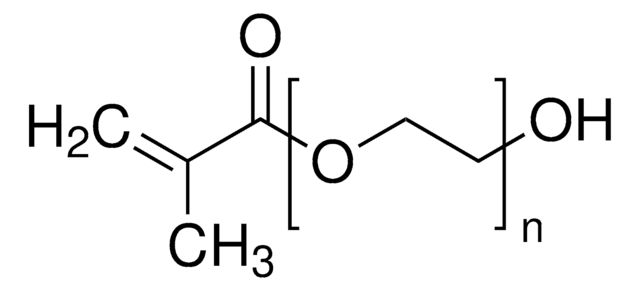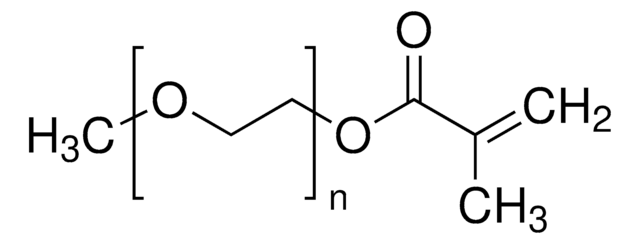Kluczowe dokumenty
409510
Poly(ethylene glycol) dimethacrylate
average MN 550, cross-linking reagent polymerization reactions, methacrylate, 80-120 ppm MEHQ as inhibitor, 270-330 ppm BHT as inhibitor
Synonim(y):
Polyethylene glycol, PEG dimethacrylate
About This Item
Polecane produkty
product name
Poly(ethylene glycol) dimethacrylate, average Mn 550, contains 80-120 ppm MEHQ as inhibitor, 270-330 ppm BHT as inhibitor
Postać
liquid
Poziom jakości
masa cząsteczkowa
average Mn 550
zawiera
270-330 ppm BHT as inhibitor
80-120 ppm MEHQ as inhibitor
przydatność reakcji
reagent type: cross-linking reagent
reaction type: Polymerization Reactions
współczynnik refrakcji
n20/D 1.466
tw
>200 °C/2 mmHg (lit.)
gęstość
1.099 g/mL at 25 °C
Ω-koniec
methacrylate
α-koniec
methacrylate
architektura polimerowa
shape: linear
functionality: homobifunctional
temp. przechowywania
2-8°C
ciąg SMILES
OCCO.CC(=C)C(O)=O
InChI
1S/C10H14O4/c1-7(2)9(11)13-5-6-14-10(12)8(3)4/h1,3,5-6H2,2,4H3
Klucz InChI
STVZJERGLQHEKB-UHFFFAOYSA-N
Szukasz podobnych produktów? Odwiedź Przewodnik dotyczący porównywania produktów
Zastosowanie
- PDGF-AA loaded photo-crosslinked chitosan-based hydrogel for promoting wound healing.: This study investigates the use of a chitosan-based hydrogel, photo-crosslinked with Poly(ethylene glycol) dimethacrylate (PEGDMA), to deliver PDGF-AA and enhance wound healing. The results demonstrate significant improvements in wound closure rates and tissue regeneration (Cai et al., 2024).
- Reducing the foreign body response on human cochlear implants and their materials in vivo with photografted zwitterionic hydrogel coatings.: This research explores the application of PEGDMA in zwitterionic hydrogel coatings to minimize foreign body responses in cochlear implants. The coatings significantly reduced inflammation and improved biocompatibility in vivo (Horne et al., 2023).
- Full factorial design of experiment-based and response surface methodology approach for evaluating variation in uniaxial compressive mechanical properties, and biocompatibility of photocurable PEGDMA-based scaffolds.: This study uses a full factorial design to optimize the mechanical properties and biocompatibility of PEGDMA-based scaffolds, highlighting their potential use in tissue engineering and regenerative medicine (Bharadwaz et al., 2023).
- Antifouling and Mechanical Properties of Photografted Zwitterionic Hydrogel Thin-Film Coatings Depend on the Cross-Link Density.: This article examines how varying the cross-link density in PEGDMA-based hydrogel coatings affects their antifouling and mechanical properties. The findings are relevant for the development of durable and biocompatible medical device coatings (Jensen et al., 2021).
- Biocompatible and photocrosslinkable poly(ethylene glycol)/keratin biocomposite hydrogels.: The research presents the development of PEGDMA/keratin biocomposite hydrogels, demonstrating excellent biocompatibility and potential applications in drug delivery systems and tissue engineering (Wang et al., 2021).
Kod klasy składowania
10 - Combustible liquids
Klasa zagrożenia wodnego (WGK)
WGK 1
Temperatura zapłonu (°F)
Not applicable
Temperatura zapłonu (°C)
Not applicable
Wybierz jedną z najnowszych wersji:
Masz już ten produkt?
Dokumenty związane z niedawno zakupionymi produktami zostały zamieszczone w Bibliotece dokumentów.
Klienci oglądali również te produkty
Produkty
Patterning of PEG-based Hydrogels - Engineering Spatial Complexity
Progress in biotechnology fields such as tissue engineering and drug delivery is accompanied by an increasing demand for diverse functional biomaterials. One class of biomaterials that has been the subject of intense research interest is hydrogels, because they closely mimic the natural environment of cells, both chemically and physically and therefore can be used as support to grow cells. This article specifically discusses poly(ethylene glycol) (PEG) hydrogels, which are good for biological applications because they do not generally elicit an immune response. PEGs offer a readily available, easy to modify polymer for widespread use in hydrogel fabrication, including 2D and 3D scaffold for tissue culture. The degradable linkages also enable a variety of applications for release of therapeutic agents.
Devising biomaterial scaffolds that are capable of recapitulating critical aspects of the complex extracellular nature of living tissues in a threedimensional (3D) fashion is a challenging requirement in the field of tissue engineering and regenerative medicine.
Nasz zespół naukowców ma doświadczenie we wszystkich obszarach badań, w tym w naukach przyrodniczych, materiałoznawstwie, syntezie chemicznej, chromatografii, analityce i wielu innych dziedzinach.
Skontaktuj się z zespołem ds. pomocy technicznej







